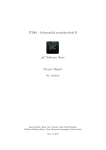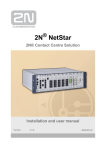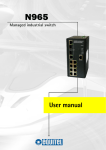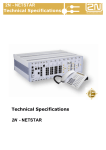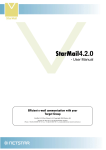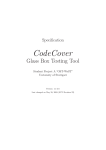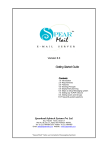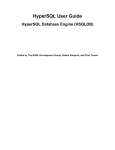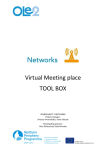Download Stockholm den den 12 oktober 2005
Transcript
StarMail 4.1.0 - Technical Manual Efficient e-mail communication with your Target Group StarMail 4.1.0 Technical Manual v1.0. Copyright 2007 Netstar AB. Netstar AB Box 3415 103 68 Stockholm, Sweden Phone. +46 (0) 8 5000 98 70 Fax. +46 (0) 8 5000 98 71 [email protected] www.netstar.se Table of Content 1. 2. 3. 4. 5. 6. 7. 8. 9. About StarMail.............................................................................................................................................................................. 3 Managing and creating recipients lists .............................................................................................................................. 3 2.1.1. Site Partitioning ...................................................................................................................................... 4 2.2. Source – Recipient List .............................................................................................................................................. 4 2.2.1. Recipient class ......................................................................................................................................... 4 2.2.2. RecipientContainer class..................................................................................................................... 5 2.2.3. Creating a Source................................................................................................................................... 5 2.2.4. Sample Code............................................................................................................................................ 5 2.3. Standard - Recipient List ........................................................................................................................................... 6 2.3.1. Import ......................................................................................................................................................... 6 2.3.2. CSV files...................................................................................................................................................... 6 2.3.3. XML .............................................................................................................................................................. 7 Order Mail....................................................................................................................................................................................... 7 3.1. Specification of StarMail Order Mail 2.0 ............................................................................................................. 8 3.1.1. Options ...................................................................................................................................................... 8 3.1.2. Mail data HTML ....................................................................................................................................... 9 3.1.3. Mail Data Text.......................................................................................................................................... 9 3.1.4. Email addresses and variables .......................................................................................................... 9 3.1.5. Encryption ............................................................................................................................................. 10 3.1.6. Headers ................................................................................................................................................... 11 Statistics ....................................................................................................................................................................................... 12 4.1. Web service ................................................................................................................................................................. 12 4.1.1. SOAP details .......................................................................................................................................... 12 4.1.2. Statistic setup ....................................................................................................................................... 13 4.1.3. What kind of Statistics is it possible to get. .............................................................................. 14 4.1.4. Bounce Management........................................................................................................................ 14 4.2. StarMail Configuration File ................................................................................................................................... 14 System Settings......................................................................................................................................................................... 16 5.1. Users and User Groups ........................................................................................................................................... 16 5.2. Administrative rights .............................................................................................................................................. 18 5.3. Site Partitioning ........................................................................................................................................................ 21 5.4. Globalization .............................................................................................................................................................. 22 5.5. Licensing ...................................................................................................................................................................... 23 Requirements ............................................................................................................................................................................ 24 6.1. Knowledge .................................................................................................................................................................. 24 6.2. System requirements .............................................................................................................................................. 24 Related products ...................................................................................................................................................................... 24 Help us get better .................................................................................................................................................................... 24 Appendix 1. StarCommunity Source Sample Code.................................................................................................... 25 2 (31) 1. About StarMail StarMail is powerful software for distribution of emails and newsletters. StarMail is designed to handle very large numbers of email recipients. StarMail consists of a client (administration) part and a server part, both of which are described in this Technical Manual. In the client part, the StarMail Editor, the email or newsletter is created and the distribution is initiated. An order email with content and recipient data is sent to our dedicated StarMail Server Cluster. This cluster of servers then distributes the emails or newsletters without consuming valuable power from the sender’s IT environment. Detailed real-time statistics for each newsletter is available instantly. 2. • The web based StarMail Editor is where the message is created. HTML mails can be composed by using the built in html editor or by selecting a page already created in EPiServer, DocStar, or by providing a URL. • An order email is sent to the StarMail Broker, which calculates the most efficient way to distribute the message to the recipients via the servers in its cluster, considering current load and queue length for each distribution server. Managing and creating recipients lists From a developers perspective all recipient sources inherits and implements the IRecipientSource Interface. Each recipient source can provide any number of recipient lists (of the type RecipientContainer). One implementation that supports recipient list import is included with StarMail Editor and does not need to be implemented by the developer. This recipient source is called “Standard” and is used whenever a list is to be imported. 3 (31) However, in many cases there is need for dynamic recipient lists, to integrate StarMail with an existing system where the recipient information resides. Most commonly, such a list is generated by database queries. To do this you need to implement the IRecipientSource Interface. Description of this and samples can be found in section 2.2. 2.1.1. Site Partitioning For larger organizations, it is possible to create different “sites” that selected users or groups can be given access to. See the section System Settings – User and user groups. 2.2. Source – Recipient List To implement your own recipient source you need to implement the IRecipientSource interface. 2.2.1. Recipient class The Recipient class is defined in the StarMail.Core namespace. The Recipient class defines the following public properties: • Guid ID - The unique identifier of the recipient • string Email - The email address of the recipient • AttributeCollection Attributes - The collection of attributes of the recipient. These attributes are used for substitution of variables in the mail body. The variables in the mail body must be in the format §a§, §b§, §c§ etc. and are substituted by the corresponding attribute where the order of attributes in the attribute collection coincides with the alphabetic order of the variable name. • bool IsUnsubscribed - Gets whether the user has been marked as unsubscribed • Guid ContainerId - Gets the unique identifier of the RecipientContainer that this Recipient is connected to. 4 (31) 2.2.2. RecipientContainer class The RecipientContainer class represents a specific list of recipients. One of the properties of a RecipientContainer is an implementation of the IRecipientSource interface that the RecipientContainer was provided by. 2.2.3. Creating a Source This section describes the properties and methods defined in the IRecipientSource Interface in the StarMail.Core namespace that needs to be implemented. • Guid ID – The unique identifier for this source. This must be constant for any given source. • bool SupportsImport – In most cases false since an implementation that supports this is already shipped with the StarMail Editor (“Standard” source). • string Name – The name of this source. This must be constant for any given source. • RecipientContainer ImportRecipients – If SupportsImport is set to false, the implementation should just return null. • RecipientContainerCollection GetRecipientContainers – should return a recipient container collection. (If the provided Site is not applicable, return your list of RecipientContainers when the Site is null.) • Recipient GetRecipient – Should return the recipient for the supplied Guid • RecipientCollection GetRecipients - Should return the recipients for the supplied RecipientContainer • void UnsubcribeRecipient – Unsubscribes or re-subscribes the supplied recipient. • RecipientContainer GetRecipientContainer – Should return the recipient container with the supplied Guid or name. • void RemoveRecipientContainer – Should remove a recipient container with the supplied guid. If removal of RecipientContainers is not supported, just return. The compiled assembly should be put in the bin directory on the web server. 2.2.4. Sample Code When running StarMail together with StarCommunity or EPiServer 4.x there are options to install implementations of IRecipientSource for these during the StarMail Installation. The StarCommunity source selects all current StarCommunity users with the subscription user attribute set. The name of the attribute can be specified in the configuration file. The EPiServer source selects all current EPiServer users. The sample code in appendix 1 is an excerpt from the StarCommunity source. When creating your own sources, you may want to start by modifying the GetRecipients method. If you are running StarCommunity you can use the user search handler to get the recipients (as in the sample). However, you can of course create customized database queries to get recipients from any database or other data source accessible. 5 (31) 2.3. Standard - Recipient List 2.3.1. Import StarMail can import E-mail address lists from XML and CSV text files (semi colon separated). 2.3.2. CSV files Most common is importing Email lists from Excel. When importing email addresses from Microsoft Excel the file needs to be saved in a specific format. Please see instructions below. The first row is a header row and is not imported to StarMail. The first column is always used as the email address. It is possible to import a list that consists of only one column with email addresses. In the example above, there are additional columns with variables such as Name, Sur Name and Title. These variables can be used for different needs and are used to personalize each email sent from StarMail. StarMail handles up to 20 variables for each recipient list. Save the Excel sheet as a CSV-file (Semi colon delimited) and make sure that the file has the format UTF-8. If it is not possible to make sure that the CSV-file is in UTF-8 format, open the file with a regular text editor, such as Notepad, and save the file again making sure that the file is in UTF-8 format. Select CSV format 6 (31) 2.3.3. XML An email list can also be imported from an XML-file. See below for an example of a compatible XML-file: <?xml version="1.0" encoding="utf-8" ?> <starMailImport> <attributes> <attribute id="1">attributeName1</attribute> <attribute id="2">attributeName2</attribute> <attribute id="3">attributeName3</attribute> </attributes> <recipient> <email>[email protected]</email> <attributeList> <attribute id="1">attribute value for <attribute id="2">attribute value for <attribute id="3">attribute value for </attributeList> </recipient> <recipient> <email>[email protected]</email> <attributeList> <attribute id="1">attribute value for <attribute id="2">attribute value for <attribute id="3">attribute value for </attributeList> </recipient> <recipient> <email>[email protected]</email> <attributeList> <attribute id="1">attribute value for <attribute id="2">attribute value for <attribute id="3">attribute value for </attributeList> </recipient> </starMailImport> 3. attr 1</attribute> attr 2</attribute> attr 3</attribute> attr 1</attribute> attr 2</attribute> attr 3</attribute> attr 1</attribute> attr 2</attribute> attr 3</attribute> Order Mail The distribution is initiated when the StarMail Server cluster receives an order mail. The order mail is created either according to below specification or with the StarMail Editor (the client part of StarMail). The order mail includes the actual email content, subject, sender information, recipients and, etc. The order mail is sent to “account”@starmail.netstar.se 7 (31) 3.1. Specification of StarMail Order Mail 2.0 Below is a an example and specification of an order mail that complies to StarMail Order Mail Version 2.0: ----options---subject: Subject Text sender: [email protected] sendername: The Name guid: f1e5693f-49b0-40f7-b526-8d3befc02ebc senddate: 2006-12-30 24:30 ----endofoptions-------maildata---<html> Hi §a§ §b§!<br> <br> Here is the content of the <i>email or Newsletter</i>. <br> Your title is §c§ </html> ----endofmaildata-------maildatatext---Hi §a§! Here is the content of the email or Newsletter. [email protected];Andreas;Stjernström;Partner Manager [email protected];Gustav;Lagercrantz;CEO [email protected];Elvis;Presley;The King [email protected];Tiger;Woods;Golf Pro [email protected];Andreas;Stjernström;Partner Manager [email protected];Gustav;Lagercrantz;CEO [email protected];Elvis;Presley;The King [email protected];Tiger;Woods;Golf Pro ----endoftextaddr---- 3.1.1. Options In the part of the order mail named ----Options---- following parameters could be set. ----options---subject: Subject Text sender: [email protected] sendername: Name guid: f1e5693f-49b0-40f7-b526-8d3befc02ebc senddate: 2006-12-30 24:30 charset: iso-8859-1 ----endofoptions---- “Subject” sets the Subject text for the message ”Sender” Sets the sender E-mail adress. ”Sendername” Sets the name of the sender. ”GUID” sets the Globally Unique Identifier of the specific newsletter to prevent the same mail from being sent out more then once. This replaces the deprecated option “Version”. 8 (31) ”Senddate” sets when the distribution starts. With this setting it is possible to schedule a distribution. Format for senddate is YYYY-MM-DD HH:MM. Setting this is optional (the entire row should be excluded if not used). 3.1.2. Mail data HTML In the part of the order mail named ----maildata---- the content of the mail is included. The maildata is only delivered to the email addresses in the order mail ----htmladdr-------maildata---<html> Hi §a§ §b§!<br> <br> Here is the content of the <br> Your title is §c§ </html> ----endofmaildata---- <i>email or Newsletter</i>. In the example above, variables are being used. The variables are inserted in the email by writing § before the variable name for example §a§. The variables are assigned names automatically; a, b, c, etc. Below are two examples of how the resulting email from the example would look like to the end user: Email 1 Hi Andreas Stjernström Here is the content of the email or Newsletter. Your title is Partner Manager Email 2 Hi Gustav Lagercrantz Here is the content of the email or Newsletter. Your title is CEO 3.1.3. Mail Data Text The part of the order mail named ----maildata---- works the same way as Maildata exept that the content could not be html. The maildata is only delivered to the email addresses in the order mail ----textaddr-------maildatatext---Hi §a§! Here is the content of the email or Newsletter. ----endofmaildatatext---- 3.1.4. Email addresses and variables In the part of the order mail named ----htmladdr---- and ----textaddr---- the addresses and variables for the distribution is included. One row for each recipient, containing email addresses and attribute values, separated by semicolon. [email protected];Andreas;Stjernström;Partner Manager 9 (31) [email protected];Gustav;Lagercrantz;CEO [email protected];Elvis;Presley;The King [email protected];Tiger;Woods;Golf Pro [email protected];Andreas;Stjernström;Partner Manager [email protected];Gustav;Lagercrantz;CEO [email protected];Elvis;Presley;The King [email protected];Tiger;Woods;Golf Pro ----endoftextaddr---- Below illustrates how the variables for the recipient on the first row are interpreted: Email address = [email protected] Variable A - §a§ = Andreas Variable B - §b§ = Stjernström Variable C - §c§ = Partner Manager 3.1.5. Encryption StarMail Order Mail Specification 2.0 is introducing support for RSA/AES-based encryption. If the <BrokerPublicKey> parameter in StarMail.config contains a valid public key at StarMail Editor initialization; all outgoing order mails are encrypted. Here is an example of an encrypted ordermail: -----BEGIN ORDERMAIL MESSAGE----Version: StarMail Client 4.1.0.0 cdRBVQS7uTf0MdUi0Q+PF6BOR9Lm3Ai01nYuvRhD1gh0hDjCIvDl1rFx5Ixkwps/bonMFg3neHIO LvTtokpdxefTO/avb3RsbpIZsa7ngD2xHUPyvu6AOTefniu+G+Ihob99O3JwwjCHf+AC76Ka7Jf1 9XcMafTYeiHUCN27NU646cCGkN3bbZGzdAWst0t+/XXvu6jAMiAcAsbJR1RN2X6wBe2fT06hjg0T 89ewNKg3Ks2+d/gtvM55EsbnHi0NksVV6NbR5OP4OYSP2PYUJ3NLX6xWzHKBPhBaFUYFxhtqcyGe ru1X3XKQP/DNpqYdnMd1wovZxcW/kS1EJWQQqvTmo2dQQV1FYLwlDNkLsuuVwizRBrMJ9k+ZO5tP B95FnlNESpgz/EP5OYd+49Di+xaTArE3DQmn87x1XYgXMRd6muhKn36D1kcGziPep59KzX1Jt0uc HMzkZB0s/jxifU9pi2QWa7w16AgcNxebhBPtPUWj0J5l4ChwuZiFFoCGFfXci1dM21j/JOGvlVb6 Sq7E/9aHTXwi5LUS3MocGhTCak65O3jFzmXQsFq+C2sjIGAzdkd78MTFdzTSgoT/sP3XWeUqVSiQ gVrt9aZQJXVK3QqX9kdQwHvZeKnrtfXqPDi7sexw4Aze3ElrZA5eZcPNafSzVzQBXngKI3d9SU4/ 0bsOgnvN3OmHEKkvmrtSARwLbJb8aPkvpjBHXbJ/HWlLK2KExk+cHFmuOvg6Z+Rjqb65AZG3CN3v eyyieqjyATSLdJ0Kusn6EPHGowcbnG/T75y45jcIOhX8qII0hWT1qtPfMjyhFlgPRJvJyiT8oNLr bmffCSWwYWuUI5TSgaCmrZJ+Oy5SiKaoaQN/Px5lq8M93kMO8DWM5tMPNbmMRa6XaRZTshhEex/U Kisp0OdT1A6THEjcrs5m+0Yufy3rgw0gOp6QL4aZGyRlifhEKlc2+o9FKnD/Dnma69C9m61WYm2j AqGPzf9at/Vv5eEdZcgUkWrMKGCvSrXMbCS7DOPFQwPhPVstMe6xkFA2amY+LQtm4IXF1EwOF8xx ndq/pWRXLzFqfYl9sxquVZX2eEJgd7KdINghyg9RnL1COQ== -----END ORDERMAIL MESSAGE----- 10 (31) -----BEGIN ORDERMAIL KEY----giLwNtgaVxYyspoYsjLt74/XfALLwm9JSXN8Z6Ynzf+2LC+Xcirln/oktq4fjDBgFwdgpqu6im0x vM/GyrDaE9Ebzf946oWvFdM4nmWxKpZX/ZPLQcDXhO+yg6n0upzkA0nhQR5hUEaPtg4Bwt6uUf7c kltM+dxOKjk8k0L1p1lWaRjWZdWP/5jdtUrg0aYIVLT6pbbWPhhP/Y9wrdKIEkrhPci+0ow0wi7E e+vN62dcFTyejSi2iOYwk9ZbEmiVpqukKyDYPJMNylh+GrNOU/rIbdJMbYkXSY2Q4esowyuHDOkw /cOKxfrjvUVK116HLLl8KzxhQbL5AI0EvQ9J0sC5F/Ar697BU6XmDE3ETiC+n9cg9E8saJwv9WVq SCKBbur1oOgiLQO9G8NGVYaJ3Z8EDIg1QBExcF0tOfbeHjo1QaJ20Bg1rQJimzwvkOz+otpjFngL uKq+J4j3wJmx3nEW5fT3XqT1RKVftsPBWwJgA1cjcIjqXuVLkqESGNKf+XjDuTw1SSyXZbPVwxzc +dbwsemSy1mI6enFaW+6oH3lO8cuKXUihDRAH/JCelLnPBUKq8hqt7uDd6rA5oFWJuSP45O8UxLr Z9+fm2AZny+Y6memYcORjhXvTYliWE5xaVtjvSvcx/2F2HMctg2LflXJ3tilvI/IBPmMAlrrtIo= -----END ORDERMAIL KEY---------BEGIN ORDERMAIL IV----cGIC2K8B3ZnMzGy5Lqt3JlYbsfMXB7N/T+L0i6Jz1t2zHkISQN/Ej6OwZ5+mmgWG/oXDdbhnhGVJ M9PV6dzJiKBjCZqhCKiw6uqkemqwofM+8herk7CzsMaQ3u+pvO0G2jsBlTq8AeQx/OPhQQk/eVOs 6LO2T9iEIdywA4K09gWyuxwxMa7bAwOuKZMzweYvcfZ/tV14P3wNjNicfpop6ew7dss9RDEO4Vtp GIy3Mnfdjgg5J0sIBH2iwO2ySwBpTSCSKe8Yh/Vdl0KPy2ObkAdA3I13u2kP+jWFTN8GM6lQcAyh zh8GnQLSsIfhduuBJH1rtaOYgRza6NwQa9MDD177o0iomps0RgG9nfX56kEX0abl3I5lElnO1cek qtWtZJpGbkdpZ19HdKH6hiVyfhAsm01H/dXlWLA0SqOBQtAC7QS9mgepSBM7TqmJ/0W2mjemuBK7 a7aOV3l071Oho6rA2XDL5oW8QwzMBWzIejP1fFQE65AWDqYOooWSN9W6GNeNIwbD8fVmp53LCGdr EdV60B3QDQfKNBhvhOVvSPqoUqlEYKOLBbTxF9OynSQpnLmQoh3UmILRwND2o63MKiGHbznRZW7L b/8zplY7gccjGWrO4gRPhW82Fv/QpVhOo929fUnPorexXGzc2dMrhJugjaRDNIWmIhFeBv5KUj0= -----END ORDERMAIL IV----- StarMail creates a unique symmetric key and uses it to encrypt the ordermail content (found starting at -----BEGIN ORDERMAIL MESSAGE-----). The symmetric key and initialization vector is then encypted with the custom public RSA key of the StarMail installation and supplies it for decryption on the server side, as shown in example above. 3.1.6. Headers From StarMail Order Mail Specification 2.0, version number is defined in the mail header as parameter “StarMail-OrderMail-Version”. 11 (31) 4. Statistics 4.1. Web service The Web Service section is only for systems that do not have the Starmail Editor installed. If you are not using the StarMail Editor but want to handle bounces you need to implement the following to web service methods, which are called from the StarMail Server Cluster: void AddBounces(int messageId, string[] emails) void AddBounce(int messageId, string email) AddBounces accepts an array of email addresses (strings) which are to be marked as bouncing. The messageId is the version provided in the order mail. AddBounce works just like AddBounces, but accepts a single email address. 4.1.1. SOAP details The WSDL specification file for the web service is available at the Netstar partner web site. Here are example calls for the web service methods returning bounces for a newsletter using StarMail Order Mail Specification 2.0 or later. Example 1a POST /Netstar/StarMail/StarMail.asmx HTTP/1.1 Content-Type: text/xml; charset=utf-8 SOAPAction: "http://netstar.se/StarMail/AddBouncesByGuid" <?xml version="1.0" encoding="utf-8"?> <soap:Envelope xmlns:xsi="http://www.w3.org/2001/XMLSchema-instance" xmlns:xsd="http://www.w3.org/2001/XMLSchema" xmlns:soap="http://schemas.xmlsoap.org/soap/envelope/"> <soap:Body> <AddBounces xmlns="http://netstar.se/StarMail/"> <messageId>f1e5693f-49b0-40f7-b526-8d3befc02ebc</messageId> <emails> <string>[email protected]</string> <string>[email protected]</string> </emails> </AddBounces> </soap:Body> </soap:Envelope> Example 1b POST /Netstar/StarMail/StarMail.asmx HTTP/1.1 Content-Type: text/xml; charset=utf-8 SOAPAction: "http://netstar.se/StarMail/AddBounceByGuid" <?xml version="1.0" encoding="utf-8"?> <soap:Envelope xmlns:xsi="http://www.w3.org/2001/XMLSchema-instance" xmlns:xsd="http://www.w3.org/2001/XMLSchema" xmlns:soap="http://schemas.xmlsoap.org/soap/envelope/"> <soap:Body> <AddBounce xmlns="http://netstar.se/StarMail/"> <messageId>f1e5693f-49b0-40f7-b526-8d3befc02ebc</messageId> <email>[email protected]</email> 12 (31) </AddBounce> </soap:Body> </soap:Envelope> Here are example calls for the web service methods returning bounces for a newsletter using a StarMail Order Mail Specification prior to 2.0. Example 2a POST /Netstar/StarMail/StarMail.asmx HTTP/1.1 Content-Type: text/xml; charset=utf-8 SOAPAction: "http://netstar.se/StarMail/AddBounces" <?xml version="1.0" encoding="utf-8"?> <soap:Envelope xmlns:xsi="http://www.w3.org/2001/XMLSchema-instance" xmlns:xsd="http://www.w3.org/2001/XMLSchema" xmlns:soap="http://schemas.xmlsoap.org/soap/envelope/"> <soap:Body> <AddBounces xmlns="http://netstar.se/StarMail/"> <messageId>17</messageId> <emails> <string>[email protected]</string> <string>[email protected]</string> </emails> </AddBounces> </soap:Body> </soap:Envelope> Example 2b POST /Netstar/StarMail/StarMail.asmx HTTP/1.1 Content-Type: text/xml; charset=utf-8 SOAPAction: "http://netstar.se/StarMail/AddBounce" <?xml version="1.0" encoding="utf-8"?> <soap:Envelope xmlns:xsi="http://www.w3.org/2001/XMLSchema-instance" xmlns:xsd="http://www.w3.org/2001/XMLSchema" xmlns:soap="http://schemas.xmlsoap.org/soap/envelope/"> <soap:Body> <AddBounce xmlns="http://netstar.se/StarMail/"> <messageId>17</messageId> <email>[email protected]</email> </AddBounce> </soap:Body> </soap:Envelope> 4.1.2. Statistic setup Statistics for number of opened emails and clicks are collected through the /Netstar/StarMail/GoMail.aspx page. This page has to be publicly available for the statistics collection to work. If the StarMail Editor is not used, it is necessary to implement such a page to make it possible to get statistics. Note that links in the HTML mail will need to be modified to go to this page prior to sending the order mail. The “gomail” page itself should to be set up to log the request and then redirect to the original destination. 13 (31) 4.1.3. What kind of Statistics is it possible to get. Opened messages Unique opened messages Unknown Export opened Clicks Export clicks When the messages opened 4.1.4. Bounce Management The StarMail server collects information about emails that bounce (not deliverable). The information is sent back to the sender using a SOAP Web Service interface. It is up to the sender to decide action on e-mail addresses that bounce. For example, if an address bounces more than two times it could be removed from the recipient list. When using the StarMail Editor and its built in bounce reporting system, bounces are recorded in the table tblStarMailBounce. 4.2. StarMail Configuration File The data in the configuration file is created when installing StarMail. To change the StarMail configuration after the installation it can be done in the StarMail Configuration file. The configuration file is located at /Netstar/StarMail/StarMail.config Below is an example of a StarMail configuration file. <?xml version="1.0" standalone="yes"?> <SettingsData xmlns="http://netstar.se/StarMail/SettingsData.xsd"> <StarMail> <BrokerAddress>[email protected]</BrokerAddress> <DefaultFromAddress>[email protected]</DefaultFromAddress> <DefaultFromName>StarMail Sender Name</DefaultFromName> <GoMailURL>http://www.domain.com/Netstar/StarMail/GoMail.aspx</GoMailURL> <StarMailFromAddress>[email protected]</StarMailFromAddress> <MailServer>smtp.domain.se</MailServer> <GoMailImageURL>http://www.domain.com/Netstar/StarMail/Images/pixel.gif</Go MailImageURL> <Encoding>iso-8859-1</Encoding> <BrokerIP>195.178.179.55</BrokerIP> 14 (31) <BrokerPublicKey> <RSAKeyValue> <Modulus>zG5Z4RaYhz5Grxlb+HVRWG2zzuGMECzngy1+OMmbOts0iZyirrZZlP69B3oh8xZJKA Z/smE7WWx31uPasRmP2bWe9OTGbF13FwLv4OiEDuA5/M3Q6kn7Srdz/VhWURfB+CwoZkdgDv5t2 wY2tRRH4b33V1/qiJ7ZB20Cuuj566LdY+gIfJod3PSOIoE8VpQq1pPeof09U70oQHZKlf974BvB jcVm4TCM5vR7G8hBZR0TAqf2rkNmby3BNAqkxpJnB9VSR6iec/XSLsisQZ39oeU2KAYgspLfi81 TyxG4ChyT/ar6Ao8MQHuapmkXG+IYANNMBAA20RP61UVrC1NfVTjjTRu5U5hMYqKB4btc3JPj9/ XgRtpMSZ+n961wuy3uXPFK86dWRlp0SNF6r++u/NB53wgmwrrWdsurYYsxCnE81gvK1CoPgKkFk 4hVBmuFytGem+Xuv3aDyA1ENtTgz7UV/DB2m3L64e6b1V4ukChzTUZXQmHejHfL21SXzbBW1/zY AigpyhZke20LB66ndlMgb+jm8S5teftK1lpUnqKGd7/O17eQa47jMBdznZ2U1MDhnYcGxDJd+4J OkW+smhRG3LrFDKfCOYIHtQRCw3OkXnL4TMjxub61V9U/AoknbamqXVlcgaUM3FKIR5Y3HayfGY uUiOQI3PDEUsE4vSU=</Modulus> <Exponent>AQAB</Exponent> </RSAKeyValue> </BrokerPublicKey> </StarMail> </SettingsData> 15 (31) 5. System Settings Here the StarMail administrator can create and remove groups or users that can help to administrate the StarMail. System Settings When System Settings is activated, the following menu is displayed 5.1. Users and User Groups Add User In the “Add User” page, you can create a new user with his basic details as well as add him to groups in order to inherit access rights. 16 (31) Add Group A group it added by specifying its name. Groups can also have child groups that inherit access rights from their parent group. Search At the “Search Group/User” page you can search for both groups and users and remove them if needed. 17 (31) 5.2. Administrative rights Administration At the administration part of the access rights section the administrator can give users and groups rights to log in to Netstar Products Administration. To add a user or group, do a search for its name, click on “Add”, check the checkbox “Access” followed by “Save”. To remove a user or group, click “Remove” followed by “Save”. 18 (31) System Settings The System Settings section contains the members and groups that have access to view the System Settings part of Netstar Product Administration. Users and groups can be added and removed in the same way as in the Administration section. 19 (31) Web Sites This section gives users and groups rights to view and do changes below the “Web Sites” section in System Settings. Adding and removing groups and users works in the same way as the other access right sections. Security At the security page, the administrator can give users and groups general security rights. This includes adding, changing and removing other users and groups. 20 (31) 5.3. Site Partitioning Below the web sites header, new websites can be created as well as existing ones updated. The administrator can choose new and the default language to use on the site. Hostnames are added by typing a name in the Hostname Alias textbox, followed by clicking on the “Add Alias” button. The Access Rights tab lets the administrator set what groups and users are allowed to operate on this site. The access rights available are Read, Create, Change, Remove and Administrate. 21 (31) 5.4. Globalization The globalization section allows the administrator to translate texts in order to have web pages available in several different languages. At the “Find Translation” tab the administrator can search for language keys and edit or remove them. New keys can easily be added on the “Add Key” tab. To edit an existing key, search for the key and click on its name. After having clicked on a key, the popup window is displayed, as shown on the screenshot below. This page displays the languages that the key has been translated to. Texts can be changed and languages can be added or removed. 22 (31) 5.5. Licensing The “Active License” page contains information that is specific for your license. It lists all products, and their modules, that are installed on your system. The license has restrictions for maximum number of sites the administrator can create and maximum number of users that can register on the community. It also contains an expiration date for the whole license as well as IP restrictions on the servers that are hosting the system. 23 (31) 6. Requirements 6.1. Knowledge StarMail requires basic knowledge of using: 6.2. Internet Explorer / Firefox Development experience (to implement Recipient Sources) System requirements Client side (administrators) 7. Internet Explorer 6 / Firefox 1.5 Related products Other products from Netstar Products AB, from which web- and community systems may be based on, include: 8. StarCommunity - software modules used to provide interactivity with target groups DocStar - web content management system used to manage all editorial web pages StarStats - for providing relevant event based statistics to support business decisions Help us get better Please send your comments and feedback on this user manual by email to [email protected]. We also appreciate if you notify us of any errors in this user manual or features you think are not described correctly. 24 (31) 9. using using using using using using using using using using Appendix 1. StarCommunity Source Sample Code System; System.Data; System.Data.Common; StarSuite.Core; StarSuite.Core.Data; StarSuite.Core.Modules; StarMail.Core; SC_Queries = StarCommunity.Core.Modules.Queries; SC_Security = StarCommunity.Core.Modules.Security; SC_Core = StarCommunity.Core; namespace StarMail.Sources.StarCommunity { /// <summary> /// Basic recipient source for StarCommunity that has a recipient container per site /// </summary> public class StarCommunitySource : IRecipientSource { private Guid m_id; private string m_subscriptionUserAttributeName; public StarCommunitySource() { m_id = new Guid("{07A3CA4C-EA15-444F-9569-C8B9916E31A2}"); LoadSettings(); if (!string.IsNullOrEmpty(m_subscriptionUserAttributeName)) { bool hasUserGuidAttribute = false; bool hasUserSubscribedAttribute = false; foreach (SC_Core.Modules.Attributes.IAttribute attribute in SC_Core.Modules.Attributes.AttributeHandler.GetAttributes(typeof(SC_Core.Modules.Security.IUse r))) { if (attribute.Name == m_subscriptionUserAttributeName) hasUserSubscribedAttribute = true; if (attribute.Name == "StarMailUserGuid") hasUserGuidAttribute = true; } if (!hasUserGuidAttribute) SC_Core.Modules.Attributes.AttributeHandler.AddAttribute(new SC_Core.Modules.Attributes.Attribute("StarMailUserGuid", typeof(SC_Core.Modules.Security.IUser), typeof(string), true)); if (!hasUserSubscribedAttribute) SC_Core.Modules.Attributes.AttributeHandler.AddAttribute(new SC_Core.Modules.Attributes.Attribute(m_subscriptionUserAttributeName, typeof(SC_Core.Modules.Security.IUser), typeof(bool), false)); } StarSuite.Core.SiteHandler.SiteAdded += new SiteEventHandler(SiteHandler_SiteAdded); StarSuite.Core.SiteHandler.SiteRemoved += new SiteEventHandler(SiteHandler_SiteRemoved); } #region IRecipientSource /// <summary> /// Gets the source's ID /// </summary> public Guid ID { 25 (31) get { return m_id; } } /// <summary> /// Gets whether the source supports importing lists /// </summary> public bool SupportsImport { get { return false; } } /// <summary> /// Gets the name of the source /// </summary> public string Name { get { return "StarCommunity"; } } /// <summary> /// Import recipients, not supported for this source /// </summary> /// <param name="name"></param> /// <param name="importDelegate"></param> /// <param name="site"></param> /// <returns></returns> public RecipientContainer ImportRecipients(string name, RecipientImportDelegate importDelegate, StarSuite.Core.Modules.ISite site) { return null; } /// <summary> /// Gets all RecipientContainers for a specific site. /// </summary> /// <param name="site">The site</param> /// <returns>The RecipientContainers belonging to this site</returns> public RecipientContainerCollection GetRecipientContainers(StarSuite.Core.Modules.ISite site) { RecipientContainerCollection all = GetAllRecipientContainers(); RecipientContainerCollection rcc = new RecipientContainerCollection(); foreach (RecipientContainer rc in all) { if (rc.Site != null && site != null) if (rc.Site.ID == site.ID) rcc.Add(rc); if (rc.Site == null && site == null) rcc.Add(rc); } return rcc; } /// <summary> /// Gets all global RecipientContainers /// </summary> /// <returns>The RecipientContainers</returns> public RecipientContainerCollection GetRecipientContainers() { return GetRecipientContainers(null); } /// <summary> 26 (31) /// Gets a Recipient by its ID /// </summary> /// <param name="guid">The Recipient ID</param> /// <returns>The Recipient</returns> public Recipient GetRecipient(Guid guid) { RecipientContainerCollection all = GetAllRecipientContainers(); // We have to check for this guid in each recipient container... foreach (RecipientContainer rc in all) { SC_Queries.UserQuery uq = new SC_Queries.UserQuery(); SC_Queries.StringCriterion starMailUserGuid = new SC_Queries.StringCriterion(); starMailUserGuid.Value = guid.ToString(); uq["StarMailUserGuid", rc.Site] = starMailUserGuid; StarSuite.Core.Modules.Security.UserCollection uc = SC_Core.StarCommunitySystem.CurrentContext.DefaultSecurity.GetQueryResult(uq); if (uc.Count >0) { SC_Security.IUser u = (SC_Security.IUser)uc[0]; return GetRecipient(u, rc); } } return null; } /// <summary> /// Gets the Recipients in specified RecipientContainer /// </summary> /// <param name="container">The RecipientContainer</param> /// <returns>The Recipients</returns> public RecipientCollection GetRecipients(RecipientContainer container) { bool isInTransaction = DatabaseHandler.InTransaction; if (!isInTransaction) DatabaseHandler.BeginTransaction(); try { DatabaseHandler.ExecuteNonQuery(true, "spStarMailUpdateStarCommunityUserGuids", (container.Site != null ? (object)container.Site.ID : null), m_subscriptionUserAttributeName); SC_Queries.UserQuery uq = new SC_Queries.UserQuery(); SC_Queries.BooleanCriterion subscriptionCriterion = new SC_Queries.BooleanCriterion(); subscriptionCriterion.Value = true; uq[m_subscriptionUserAttributeName, container.Site] = subscriptionCriterion; StarSuite.Core.Modules.Security.UserCollection uc = SC_Core.StarCommunitySystem. CurrentContext.DefaultSecurity.GetQueryResult(uq); RecipientCollection rc = new RecipientCollection(); foreach (SC_Security.IUser u in uc) { Recipient r = GetRecipient(u, container); if (r != null) rc.Add(r); } return rc; if (!isInTransaction) DatabaseHandler.Commit(); } catch (Exception) { if (!isInTransaction) DatabaseHandler.Rollback(); throw; 27 (31) } } /// <summary> /// Sets unsubscribed status for specified Recipient /// </summary> /// <param name="recipient">The Recipient</param> /// <param name="isUnsubscribed">Whether the Recipient should be unsubscribed</param> public void UnsubcribeRecipient(Recipient recipient, bool isUnsubscribed) { RecipientContainer container = GetRecipientContainer(recipient.ContainerId); SC_Queries.UserQuery uq = new SC_Queries.UserQuery(); SC_Queries.StringCriterion starMailUserGuid = new SC_Queries.StringCriterion(); starMailUserGuid.Value = recipient.ID.ToString(); uq["StarMailUserGuid", container.Site] = starMailUserGuid; StarSuite.Core.Modules.Security.UserCollection uc = SC_Core.StarCommunitySystem.CurrentContext.DefaultSecurity.GetQueryResult(uq); if (uc.Count >0) { SC_Security.IUser u = (SC_Security.IUser)uc[0]; if (isUnsubscribed) u.SetAttributeValue<bool>(m_subscriptionUserAttributeName, container.Site, false); else u.SetAttributeValue<bool>(m_subscriptionUserAttributeName, container.Site, true); SC_Core.StarCommunitySystem.CurrentContext.DefaultSecurity.UpdateUser(u); } } /// <summary> /// Gets a RecipientContainer by its ID /// </summary> /// <param name="guid">The RecipientContainer's ID</param> /// <returns>The RecipientContainer</returns> public RecipientContainer GetRecipientContainer(Guid guid) { RecipientContainerCollection rcc = GetAllRecipientContainers(); foreach (RecipientContainer rc in rcc) { if (guid == rc.ID) return rc; } return null; } /// <summary> /// Gets a RecipientContainer by its name /// </summary> /// <param name="name">The RecipientContainer's name</param> /// <returns>The RecipientContainer</returns> public RecipientContainer GetRecipientContainer(string name) { RecipientContainerCollection rcc = GetAllRecipientContainers(); foreach (RecipientContainer rc in rcc) { if (name == rc.Name) return rc; } return null; } /// <summary> /// Remove a RecipientContainer by its ID, this is not supported for this source /// </summary> 28 (31) /// <param name="containerId">The RecipientContainer's ID</param> public void RemoveRecipientContainer(Guid containerId) { return; // Can't remove this list. } #endregion IRecipientSource #region methods /// <summary> /// Gets all recipient containers /// </summary> /// <returns></returns> private RecipientContainerCollection GetAllRecipientContainers() { using (DbDataReader reader = DatabaseHandler.GetReader("spStarMailGetStarCommunitySites")) { RecipientContainerCollection rcc = new RecipientContainerCollection(); while (reader.Read()) { int siteId; int recipientCount; string name; if (reader.IsDBNull(0)) { siteId = -1; recipientCount = GetRecipientCountBySite(null); name = "All users"; } else { siteId = reader.GetInt32(0); Site site = StarSuite.Core.SiteHandler.GetSite(siteId); if (site == null) break; if (((SC_Security.IUser)SC_Core.StarCommunitySystem. CurrentContext.DefaultSecurity.NewUser). GetAttribute(m_subscriptionUserAttributeName, site) == null) break; recipientCount = GetRecipientCountBySite(site); name = "All users on " + site.Name; } rcc.Add(new RecipientContainer(reader.GetGuid(1), name, recipientCount, m_id, DateTime.Now, siteId)); } return rcc; } } /// <summary> /// Gets a Recipient by StarCommunity User and RecipientContainer /// </summary> /// <param name="user"></param> /// <param name="container"></param> /// <returns></returns> private Recipient GetRecipient(SC_Security.IUser user, RecipientContainer container) { AttributeCollection ac = new AttributeCollection(); ac.Add(new StarMail.Core.Attribute("First name", user.GivenName)); ac.Add(new StarMail.Core.Attribute("Last name", user.SurName)); bool unsubscribed = !user.GetAttributeValue<bool>(m_subscriptionUserAttributeName, container.Site); string userGuid = user.GetAttributeValue<string>("StarMailUserGuid", container.Site); if (userGuid != null) 29 (31) { Recipient r = new Recipient(new Guid(userGuid), user.EMail, unsubscribed, container.ID, ac); return r; } else return null; } /// <summary> /// Gets Recipient count by Site /// </summary> /// <param name="site"></param> /// <returns></returns> private int GetRecipientCountBySite(Site site) { SC_Queries.UserQuery uq = new SC_Queries.UserQuery(); SC_Queries.BooleanCriterion subscriptionCriterion = new SC_Queries.BooleanCriterion(); subscriptionCriterion.Value = true; uq[m_subscriptionUserAttributeName, site] = subscriptionCriterion; int count = 0; StarSuite.Core.Modules.Security.UserCollection uc = SC_Core.StarCommunitySystem. CurrentContext.DefaultSecurity.GetQueryResult(uq, 1, 1, out count); return count; } /// <summary> /// Help method to load in the settings for this module. /// Will set the static variable upload file path. /// </summary> public void LoadSettings() { SettingsData settings = new SettingsData(); string path = System.IO.Path.Combine(AppDomain.CurrentDomain.BaseDirectory, @"Netstar\StarMail\StarMailStarCommunitySource.config"); settings.ReadXml(path); if(settings.StarMailStarCommunitySource.Rows.Count > 0) { SettingsData.StarMailStarCommunitySourceRow starCommunitySource = (SettingsData.StarMailStarCommunitySourceRow)settings.StarMailStarCommunitySource.Rows[0]; m_subscriptionUserAttributeName = starCommunitySource.SubscriptionUserAttributeName; } } /// <summary> /// Handles added sites /// </summary> /// <param name="args"></param> private void SiteHandler_SiteAdded(SiteEventArgs args) { bool isInTransaction = DatabaseHandler.InTransaction; if (!isInTransaction) DatabaseHandler.BeginTransaction(); try { DatabaseHandler.ExecuteNonQuery("spStarMailAddStarCommunitySiteSource", args.Site.ID, m_subscriptionUserAttributeName); if (!isInTransaction) DatabaseHandler.Commit(); } catch (Exception) { if (!isInTransaction) DatabaseHandler.Rollback(); throw; 30 (31) } } /// <summary> /// Handles removed sites /// </summary> /// <param name="args"></param> private void SiteHandler_SiteRemoved(SiteEventArgs args) { bool isInTransaction = DatabaseHandler.InTransaction; if (!isInTransaction) DatabaseHandler.BeginTransaction(); try { DatabaseHandler.ExecuteNonQuery("spStarMailRemoveStarCommunitySiteSource", args.Site.ID, m_subscriptionUserAttributeName); if (!isInTransaction) DatabaseHandler.Commit(); } catch (Exception) { if (!isInTransaction) DatabaseHandler.Rollback(); throw; } } #endregion methods } } 31 (31)































